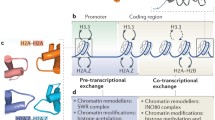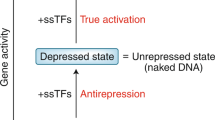Abstract
As eukaryotes are characterized by the presence of chromatin (intricately packaged DNA), special mechanisms are required for preparing the DNA template for operation of the transcription machinery. Recently, a close association between the chromatin state and transcription was found and numerous transcription factors modifying the physical and chemical chromatin state were revealed. This review presents a brief description of transcription initiation on the DNA template within chromatin.
Similar content being viewed by others
REFERENCES
Sims, R.J. III, Mandal, S.S., and Reinberg, D., Recent Highlights of RNA Polymerase II-Mediated Transcription, Curr. Opin. Cell. Biol., 2004, vol. 16, pp. 263–271.
Lodish, H., Berk, A., Matsudaira, P., et al., Molecular Cell Biology, New York: Freeman, 2004, 5th ed.
Narlikar, G.J., Fan, H.Y., and Kingston, R.E., Cooperation between Complexes That Regulate Chromatin Structure and Transcription, Cell (Cambridge, Mass.), 2002, vol. 108, pp. 475–487.
Morales, V., Giamarchi, C., Chailleux, C., et al., Chromatin Structure and Dynamics: Functional Implications, Biochimie, 2001, vol. 83, pp. 1029–1039.
Tyler, J.K., Chromatin Assembly: Cooperation between Histone Chaperones and ATP-Dependent Nucleosome Remodeling Machines, Eur. J. Biochem., 2002, vol. 269, pp. 2268–2274.
Grunstein, M., Histones As Regulators of Genes, Sci. Am., 1992, vol. 267, pp. 68–74.
Naar, A.M., Lemon, B.D., and Tjian, R., Transcriptional Coactivator Complexes, Annu. Rev. Biochem., 2001, vol. 70, pp. 475–501.
Carey, M. and Smale, S.T., Transcriptional Regulation in Eucariotes, New York: CSHL, 2000.
Cosma, M.P., Ordered Recruitment: Gene-Specific Mechanism of Transcription Activation, Mol. Cell, 2002, vol. 10, pp. 227–236.
Mason, P.B. and Struhl, K., The FACT Complex Travels with Elongating RNA Polymerase II and Is Important for the Fidelity of Transcriptional Initiation in Vivo, Mol. Cell. Biol., 2003, vol. 23, pp. 8323–8333.
Studitsky, V.M., Walter, W., Kireeva, M., et al., Chromatin Remodeling by RNA Polymerases, Trends Biochem. Sci., 2004, vol. 29, pp. 127–135.
Alvarez, M., Rhodes, S.J., and Bidwell, J.P., Context-Dependent Transcription: All Politics Is Local, Gene, 2003, vol. 313, pp. 43–57.
Zhimulev, I.F. and Belyaeva, E.S., Heterochromatin, Position Effect, and Genetic Silencing, Rus. J. Genet., 2003, vol. 39, no.2, pp. 133–146.
Redi, C.A., Garagna, S., Zacharias, H., et al., The Other Chromatin, Chromosoma, 2001, vol. 110, pp. 136–147.
Richards, E.J. and Elgin, S.C., Epigenetic Codes for Heterochromatin Formation and Silencing: Rounding Up the Usual Suspects, Cell (Cambridge, Mass.), 2002, vol. 108, pp. 489–500.
Eissenberg, J.C. and Elgin, S.C., The HP1 Protein Family: Getting a Grip on Chromatin, Curr. Opin. Genet. Dev., 2000, vol. 10, pp. 204–210.
Sun, F.L., Cuaycong, M.H., Craig, C.A., et al., The Fourth Chromosome of Drosophila melanogaster: Interspersed Euchromatic and Heterochromatic Domains, Proc. Natl. Acad. Sci. USA, 2000, vol. 97, pp. 5340–5345.
Horn, P.J. and Peterson, C.L., Molecular Biology: Chromatin Higher Order Folding-Wrapping Up Transcription, Science, 2002, vol. 297, pp. 1824–1827.
Becker, P.B. and Horz, W., ATP-Dependent Nucleosome Remodeling, Annu. Rev. Biochem., 2002, vol. 71, pp. 247–273.
Lusser, A. and Kadonaga, J.T., Chromatin Remodeling by ATP-Dependent Molecular Machines, BioEssays, 2003, vol. 25, pp. 1192–1200.
Holstege, F.C., Jennings, E.G., Wyrick, J.J., et al., Dissecting the Regulatory Circuitry of a Eukaryotic Genome, Cell (Cambridge, Mass.), 1998, vol. 95, pp. 717–728.
Tsukiyama, T., The In Vivo Functions of ATP-Dependent Chromatin-Remodeling Factors, Nat. Rev. Mol. Cell Biol., 2002, vol. 3, pp. 422–429.
Vignali, M., Hassan, A.H., Neely, K.E., et al., ATP-Dependent Chromatin-Remodeling Complexes, Mol. Cell. Biol., 2000, vol. 20, pp. 1899–1910.
Dimova, D., Nackerdien, Z., Furgeson, S., et al., A Role for Transcriptional Repressors in Targeting the Yeast Swi/Snf Complex, Mol. Cell, 1999, vol. 4, pp. 75–83.
Corona, D.F. and Tamkun, J.W., Multiple Roles for ISWI in Transcription, Chromosome Organization and DNA Replication, Biochim. Biophys. Acta, 2004, vol. 1677, pp. 113–119.
Shimono, Y., Murakami, H., Kawai, K., et al., Mi-2 β Associates with BRG1 and RET Finger Protein at the Distinct Regions with Transcriptional Activating and Repressing Abilities, J. Biol. Chem., 2003, vol. 278, pp. 51 638–51 645.
Kouzarides, T., Chromatin-Modifying Enzymes in Transcription and Cancer, Biochem. Soc. Trans., 2003, vol. 31, pp. 741–743.
Jenuwein, T. and Allis, C.D., Translating the Histone Code, Science, 2001, vol. 293, pp. 1074–1080.
Eberharter, A. and Becker, P.B., Histone Acetylation: A Switch between Repressive and Permissive Chromatin. Second in Review Series on Chromatin Dynamics, EMBO Rep., 2002, vol. 3, pp. 224–229.
Yamagoe, S., Kanno, T., Kanno, Y., et al., Interaction of Histone Acetylases and Deacetylases in Vivo, Mol. Cell. Biol., 2003, vol. 23, pp. 1025–1033.
Berger, S.L., Histone Modifications in Transcriptional Regulation, Curr. Opin. Genet. Dev., 2002, vol. 12, pp. 142–148.
Featherstone, M., Coactivators in Transcription Initiation: Here Are Your Orders, Curr. Opin. Genet. Dev., 2002, vol. 12, pp. 149–155.
Maile, T., Kwoczynski, S., Katzenberger, R.J., et al., TAF1 Activates Transcription by Phosphorylation of Serine 33 in Histone H2B, Science, 2004, vol. 304, pp. 1010–1014.
Zhang, Y., Transcriptional Regulation by Histone Ubiquitination and Deubiquitination, Genes Dev., 2003, vol. 17, pp. 2733–2740.
Henry, K.W., Wyce, A., Lo, W.S., et al., Transcriptional Activation Via Sequential Histone H2B Ubiquitylation and Deubiquitylation, Mediated by SAGA-Associated Ubp8, Genes Dev., 2003, vol. 17, pp. 2648–2663.
Rouleau, M. and Aubin, R.A., Poirier G.G. Poly(ADP-Ribosyl) ated Chromatin Domains: Access Granted, J. Cell Sci., 2004, vol. 117, pp. 815–825.
Sterner, D.E. and Berger, S.L., Acetylation of Histones and Transcription-Related Factors, Microbiol. Mol. Biol. Rev., 2000, vol. 64, pp. 435–459.
Champagne, N., Bertos, N.R., Pelletier, N., et al., Identification of a Human Histone Acetyltransferase Related to Monocytic Leukemia Zinc Finger Protein, J. Biol. Chem., 1999, vol. 274, pp. 28 528–28 536.
Martinez, E., Palhan, V.B., Tjernberg, A., et al., Human STAGA Complex Is a Chromatin-Acetylating Transcription Coactivator That Interacts with Pre-mRNA Splicing and DNA Damage-Binding Factors in Vivo, Mol. Cell. Biol., 2001, vol. 21, pp. 6782–6795.
Bhaumik, S.R. and Green, M.R., Differential Requirement of SAGA Components for Recruitment of TATA-Box-Binding Protein to Promoters in Vivo, Mol. Cell. Biol., 2002, vol. 22, pp. 7365–7371.
Barlev, N.A., Emelyanov, A.V., Castagnino, P., et al., A Novel Human Ada2 Homologue Functions with Gcn5 or Brg1 to Coactivate Transcription, Mol. Cell. Biol., 2003, vol. 23, pp. 6944–6957.
Kusch, T., Guelman, S., Abmayr, S.M., et al., Two Drosophila Ada2 Homologues Function in Different Multiprotein Complexes, Mol. Cell. Biol., 2003, vol. 23, pp. 3305–3319.
Huisinga, K.L. and Pugh, B.F., A Genome-Wide Housekeeping Role for TFIID and a Highly Regulated Stress-Related Role for SAGA in Saccharomyces cerevisiae, Mol. Cell, 2004, vol. 13, pp. 573–585.
Kurdistani, S.K. and Grunstein, M., Histone Acetylation and Deacetylation in Yeast, Nat. Rev. Mol. Cell Biol., 2003, vol. 4, pp. 276–284.
Thiagalingam, S., Cheng, K.H., Lee, H.J., et al., Histone Deacetylases: Unique Players in Shaping the Epigenetic Histone Code, Ann. New York Acad. Sci., 2003, vol. 983, pp. 84–100.
DiRenzo, J., Shang, Y., Phelan, M., et al., BRG-1 Is Recruited to Estrogen-Responsive Promoters and Cooperates with Factors Involved in Histone Acetylation, Mol. Cell. Biol., 2000, vol. 20, pp. 7541–7549.
Fazzio, T.G., Kooperberg, C., Goldmark, J.P., et al., Widespread Collaboration of Isw2 and Sin3-Rpd3 Chromatin Remodeling Complexes in Transcriptional Repression, Mol. Cell. Biol., 2001, vol. 21, pp. 6450–6460.
Syntichaki, P., Topalidou, I., and Thireos, G., The Gcn5 Bromodomain Co-Ordinates Nucleosome Remodeling, Nature, 2000, vol. 404, pp. 414–417.
Author information
Authors and Affiliations
Additional information
__________
Translated from Genetika, Vol. 41, No. 7, 2005, pp. 884–893.
Original Russian Text Copyright © 2005 by Shidlovskii, Nabirochkina.
Rights and permissions
About this article
Cite this article
Shidlovskii, Y.V., Nabirochkina, E.N. The Effect of Chromatin Remodeling and Modification on RNA-Polymerase-Mediated Transcription Initiation. Russ J Genet 41, 720–727 (2005). https://doi.org/10.1007/s11177-005-0151-4
Received:
Issue Date:
DOI: https://doi.org/10.1007/s11177-005-0151-4




